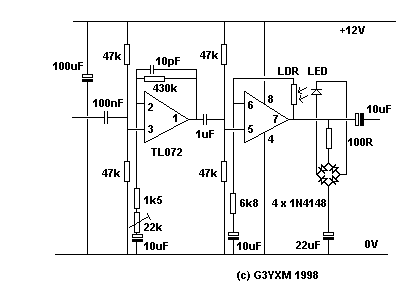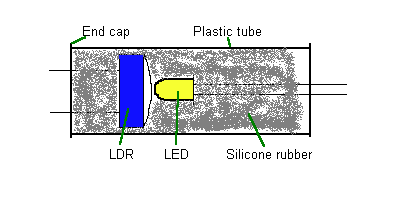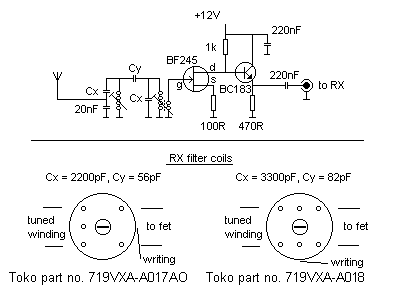The circuits page
On this page I will feature some useful circuits that I've used over the years.
COMPRESSOR . .50A trip . .136 preamp . .LF loop preamp . .50A keyer.
![]()
Audio level control device.
Starting with an audio compressor ( well you've got to start somewhere! ). There have been umpteen designs for compressors published over the years but many of them are difficult to set up or cause distortion and others use expensive chips.
This one updates an old principal I used years ago: a light bulb driven by audio illuminates an LDR in the feedback loop. The brighter the light tends to glow, the lower the resistance of the LDR becomes and the more negative feedback gets applied, reducing the gain. The LDR is purely resistive so the amplifier maintains good linearity.
The problem with a light bulb is its' thermal inertia, the attack time of the AGC circuit is too slow and you get distortion on peaks. What we needed was a fast light bulb.... We now have one, the light emitting diode!

The circuit is shown above and should cost about £10 if you have to buy all the bits new.
The NORP12 L.D.R has a dark resistance of around 1MegOhm but will come down to a few hundred Ohms in bright light. It's peak sensitivity is to yellowish light at a wavelength of around 580nM. The best match is, of course, a yellow LED. Toshiba have some nice bright ones with a peak output at 590nM which is close enough!
The crux of the thing is to mount the LDR and LED in close optical contact whilst being careful to exclude all stray light from the assembly. I mounted mine in a piece of black plastic tubing and sealed it with silicone rubber and black end-caps.

The op-amps are two halves of a TL072 and have enough gain to bring a mike insert up to a good loud line level. Performance has been measured as below.
Performance with gain set to Max.
| Input level | Output level | |
| theshold of compression | 20uV RMS | 1.9V RMS |
| maximum input level | 3mV RMS | 2.6V RMS |
40dB input range is compressed to 3dB output change.
Distortion is less than 0.2% within normal operating range.
Frequency response is 30Hz to 8kHz within 3dB at max gain.
The current drawn at 12V is only about 4mA.
Specialised components
| Component | Farnell part number | Cost ( ex VAT and carriage ) |
| Op amp Chip TL072 | 401-146 | £0.65 |
| Light dependant resistor NORP12 | 327-700 | £1.08 |
| Toshiba yellow ultra-high-bright LED | 623-714 | £0.74 |
The resistors are nothing special, 0.4W metal film are OK; the diodes are small signal diodes such as 1N4148 and the capacitors are at least 12V working.
Do not attempt to operate the circuit below 12V as there won't be enough drive to the LED and clipping will result. Using germanium diodes instead of silicon ones would give a little more headroom ( and slightly reduce the output level ).
Top![]()
Take a high-current trip.
This one is useful if you are experimenting with high current circuits (like mosfet PAs!). It is a trip which will quickly break the circuit when the current exceeds about 50A. The pass transistor is a power fet with an on-resistance of 0.007 Ohms. This means that at 50A it will drop about 0.35V, just enough to turn a germanium transistor on.... Yes that's the snag, you need a good junkbox with some OC140s or something similar in it! As the transistor starts to conduct, it will reduce the gate Voltage on the fet and begin to turn it off, this causes the Volt drop to increase and it avalanches itself into the tripped state with the LED glowing merrily. Pressing the reset button shorts out the base bias of the transistor allowing the fet to turn on again. Only press this when you're sure you know why it tripped in the first place!

The 9V battery will last for ages in the untripped state because the only current drawn is the leakage of the transistor which should be a few microamps.
| Component | part number | Cost ( ex VAT and carriage ) |
| HUF75345G3 | Farnell 247-030 | £5.30 + VAT |
| LED (red) | any sort | pence |
| Ge NPN transistor | see list below | free from your junk box? |
If you want it to trip at a lower current you can add a bit of resistance at X, it's best to do this by trial and error, just a few inches of reasonably thick wire should do. Do not use it at more than 12V or so, or the current through the 4k7 resistor will exceed the base current rating of the transistor when tripped.
It's all a bit experimental but it works pretty well, you made need to add some Cs here and there to prevent unwanted trips.
Possible germanium NPN devices.
- AC127
- AC157
- AC168
- AC176
- AC187
- ASY28
- ASY29
- NKT713 to NKT781
- OC139
- OC140
- OC141
- 2N797
- 2N1302
- 2N1304
- 2N1306
- 2N1308
Have a good root through your tat box and you may find one of these, it's a pretty comprehensive list! I'm not guaranteeing that all of these will work, most of them will be thirty years old and may be a bit leaky.... best to check 'em first. I used an OC140 in mine.
Top![]()
Pre-amp / filter for 136kHz.
Most modern tranceivers cover LF but the performance is not always very good. All you can hear are strange whistles and burbles which aren't really there! You need this little circuit. It has a gain of about 10dB and a nice sharp band-pass response about 3kHz wide, enough to cover the 136 band.

The coils are Toko type 719VXA-A017A0 and are available from BEC on 01753 549 502 at about 90p each. If they are out of stock try type 719VXA-A018AO which has a slightly lower inductance. Note the different pinouts!
More gain can be had by connecting the fet gate to the top of the second tuned-circuit, instead of the overwind. Done this way, you could use any variable inductor with an inductance of around 680uH.
Top![]()
Loop Pre-amp for LF.
If you want to use a a small multi-turn loop on LF, you will find that the sensitivity is not good enough to receive the weaker signals. A good preamp for a loop needs to have a high input impedance and good signal handling characteristics (to prevent cross-modulation). The circuit shown below is the best I tried and has enabled me to hear Italian amateur signals on the 136kHz band with a 1m diameter tuned loop. The preamp is meant to be mounted outside, near the loop, and is powered down the coax from a 12V supply in the shack. The +12V is applied via another choke at the RX end. A blocking capacitor is also required to prevent 12V being applied to the RX input.

The loop I used for 136kHz had about 30turns of 22g wire wound round a 1mtr square former and tuned with a 1000pF variable C. The preamp is fed from a two-turn coupling loop just inside the main coil. The preamp also seems to work quite well with a tuned whip aerial.
Top![]()
Keyed PSU for class D transmitters.
Keying the drive to a class-D mosfet PA can create key-clicks due to the non-linear characteristic of the PA. A nice clean keying shape can be achieved by keying the supply with appropriate rise and fall times. In this design the series regulator is keyed thus "killing two birds with one stone", regulating and smoothing the supply and keying the PA. Two seperate rectifiers and smoothing Cs are combined to give adequate capacity.

The power-fets need to be mounted on a large heatsink and may need force-cooling. I mounted the 40A bridge rectifiers on the heatsink too. This is big stuff, engineer it accordingly.
Top![]()
I'll try and add some more useful circuits over the next few months. If you have any that you think should be seen on here, e-mail me!